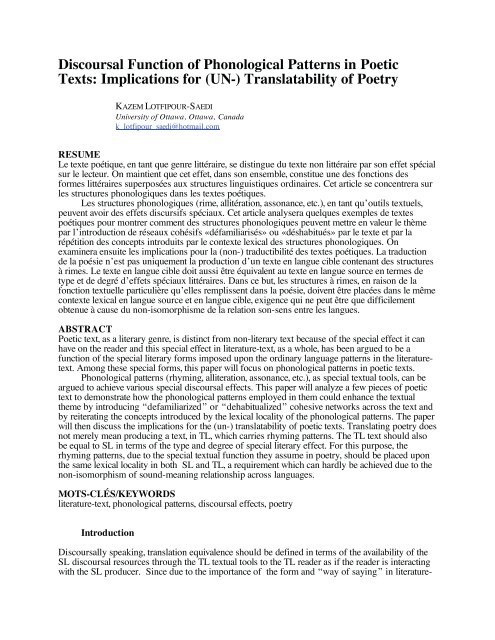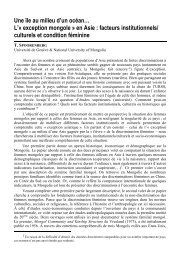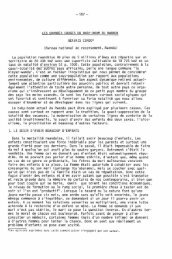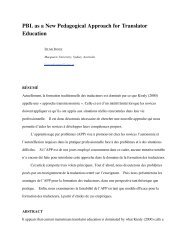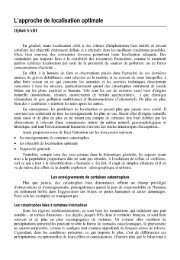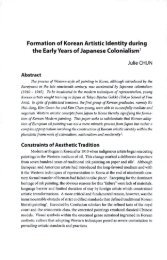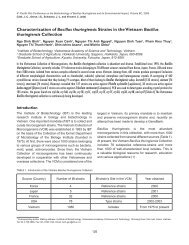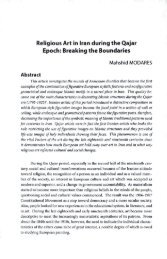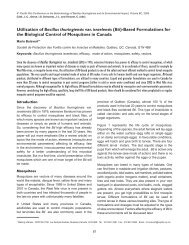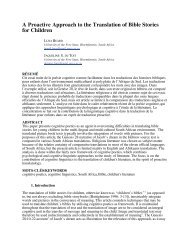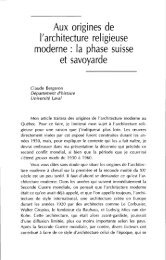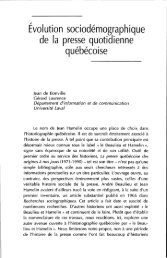Discoursal Function of Phonological Patterns in Poetic Texts ...
Discoursal Function of Phonological Patterns in Poetic Texts ...
Discoursal Function of Phonological Patterns in Poetic Texts ...
Create successful ePaper yourself
Turn your PDF publications into a flip-book with our unique Google optimized e-Paper software.
<strong>Discoursal</strong> <strong>Function</strong> <strong>of</strong> <strong>Phonological</strong> <strong>Patterns</strong> <strong>in</strong> <strong>Poetic</strong><br />
<strong>Texts</strong>: Implications for (UN-) Translatability <strong>of</strong> Poetry<br />
KAZEM LOTFIPOUR-SAEDI<br />
University <strong>of</strong> Ottawa, Ottawa, Canada<br />
k_lotfipour_saedi@hotmail.com<br />
RESUME<br />
Le texte poétique, en tant que genre littéraire, se dist<strong>in</strong>gue du texte non littéraire par son effet spécial<br />
sur le lecteur. On ma<strong>in</strong>tient que cet effet, dans son ensemble, constitue une des fonctions des<br />
formes littéraires superposées aux structures l<strong>in</strong>guistiques ord<strong>in</strong>aires. Cet article se concentrera sur<br />
les structures phonologiques dans les textes poétiques.<br />
Les structures phonologiques (rime, allitération, assonance, etc.), en tant qu’outils textuels,<br />
peuvent avoir des effets discursifs spéciaux. Cet article analysera quelques exemples de textes<br />
poétiques pour montrer comment des structures phonologiques peuvent mettre en valeur le thème<br />
par l’<strong>in</strong>troduction de réseaux cohésifs «défamiliarisés» ou «déshabitués» par le texte et par la<br />
répétition des concepts <strong>in</strong>troduits par le contexte lexical des structures phonologiques. On<br />
exam<strong>in</strong>era ensuite les implications pour la (non-) traductibilité des textes poétiques. La traduction<br />
de la poésie n’est pas uniquement la production d’un texte en langue cible contenant des structures<br />
à rimes. Le texte en langue cible doit aussi être équivalent au texte en langue source en termes de<br />
type et de degré d’effets spéciaux littéraires. Dans ce but, les structures à rimes, en raison de la<br />
fonction textuelle particulière qu’elles remplissent dans la poésie, doivent être placées dans le même<br />
contexte lexical en langue source et en langue cible, exigence qui ne peut être que difficilement<br />
obtenue à cause du non-isomorphisme de la relation son-sens entre les langues.<br />
ABSTRACT<br />
<strong>Poetic</strong> text, as a literary genre, is dist<strong>in</strong>ct from non-literary text because <strong>of</strong> the special effect it can<br />
have on the reader and this special effect <strong>in</strong> literature-text, as a whole, has been argued to be a<br />
function <strong>of</strong> the special literary forms imposed upon the ord<strong>in</strong>ary language patterns <strong>in</strong> the literaturetext.<br />
Among these special forms, this paper will focus on phonological patterns <strong>in</strong> poetic texts.<br />
<strong>Phonological</strong> patterns (rhym<strong>in</strong>g, alliteration, assonance, etc.), as special textual tools, can be<br />
argued to achieve various special discoursal effects. This paper will analyze a few pieces <strong>of</strong> poetic<br />
text to demonstrate how the phonological patterns employed <strong>in</strong> them could enhance the textual<br />
theme by <strong>in</strong>troduc<strong>in</strong>g “defamiliarized” or “dehabitualized” cohesive networks across the text and<br />
by reiterat<strong>in</strong>g the concepts <strong>in</strong>troduced by the lexical locality <strong>of</strong> the phonological patterns. The paper<br />
will then discuss the implications for the (un-) translatability <strong>of</strong> poetic texts. Translat<strong>in</strong>g poetry does<br />
not merely mean produc<strong>in</strong>g a text, <strong>in</strong> TL, which carries rhym<strong>in</strong>g patterns. The TL text should also<br />
be equal to SL <strong>in</strong> terms <strong>of</strong> the type and degree <strong>of</strong> special literary effect. For this purpose, the<br />
rhym<strong>in</strong>g patterns, due to the special textual function they assume <strong>in</strong> poetry, should be placed upon<br />
the same lexical locality <strong>in</strong> both SL and TL, a requirement which can hardly be achieved due to the<br />
non-isomorphism <strong>of</strong> sound-mean<strong>in</strong>g relationship across languages.<br />
MOTS-CLÉS/KEYWORDS<br />
literature-text, phonological patterns, discoursal effects, poetry<br />
Introduction<br />
<strong>Discoursal</strong>ly speak<strong>in</strong>g, translation equivalence should be def<strong>in</strong>ed <strong>in</strong> terms <strong>of</strong> the availability <strong>of</strong> the<br />
SL discoursal resources through the TL textual tools to the TL reader as if the reader is <strong>in</strong>teract<strong>in</strong>g<br />
with the SL producer. S<strong>in</strong>ce due to the importance <strong>of</strong> the form and “way <strong>of</strong> say<strong>in</strong>g” <strong>in</strong> literature-
text, especially <strong>in</strong> poetry, the border l<strong>in</strong>e between discourse and text or “what is said” and “the<br />
way it is said” disappears and form assumes as much significance as mean<strong>in</strong>g, translation <strong>of</strong> poetic<br />
texts poses a real challenge. To demonstrate this, we shall look at a Persian sonnet analyz<strong>in</strong>g the<br />
way its special rhym<strong>in</strong>g patterns contribute to the discourse process and discuss<strong>in</strong>g the obstacles<br />
encountered <strong>in</strong> their translation.<br />
Translation: an Act <strong>of</strong> “Relay<strong>in</strong>g” not “Convey<strong>in</strong>g”<br />
Accord<strong>in</strong>g to the discoursal view <strong>of</strong> language, mean<strong>in</strong>gs and messages are not carried <strong>in</strong> their pretailored<br />
and ready-made shape by texts; they are <strong>in</strong>teractively and “dialogically” (Bakht<strong>in</strong> 1981)<br />
negotiated by the participants; and texts act only as <strong>in</strong>terface mediators between the producer and<br />
receiver discourse processes. Thus, the message to be negotiated from a text would depend not only<br />
on the text factors but also on the receiver factors <strong>in</strong>clud<strong>in</strong>g the amount <strong>of</strong> orientation background<br />
knowledge.<br />
Translat<strong>in</strong>g as an act with the <strong>in</strong>tention <strong>of</strong> mak<strong>in</strong>g a text <strong>in</strong> one language accessible to the<br />
speakers <strong>of</strong> another language cannot, thus, be def<strong>in</strong>ed <strong>in</strong> terms <strong>of</strong> “replacement” (Lotfipour-Saedi<br />
2000) <strong>of</strong> SL elements (forms and mean<strong>in</strong>gs) by “equivalent” TL ones. Firstly, languages, as<br />
“unique structural systems” (Saussure 1959) cannot all be said to possess the same forms;<br />
secondly, the relationship between “forms” and “mean<strong>in</strong>gs” is not <strong>of</strong> the same pattern; and last<br />
but not least, as noted above, mean<strong>in</strong>gs are not “carried” or “conveyed” by the texts.<br />
On the basis <strong>of</strong> this view <strong>of</strong> language, we def<strong>in</strong>e translat<strong>in</strong>g as an act <strong>of</strong> “relay<strong>in</strong>g” the SL<br />
discoursal conditions to the TL reader so that they (SL text author and TL receiver) can <strong>in</strong>teract with<br />
one another directly and we characterize translation equivalence accord<strong>in</strong>gly along certa<strong>in</strong> “aspects<br />
<strong>of</strong> textual structure” and “dimensions <strong>of</strong> discoursal value” (Lotfipour-Saedi : forthcom<strong>in</strong>g).<br />
Among the aspects <strong>of</strong> textual structure for the characterization <strong>of</strong> translation equivalence (TE),<br />
the follow<strong>in</strong>g can be cited: vocabulary, structure, texture, language variety, extraneous l<strong>in</strong>guistic<br />
choices, prom<strong>in</strong>ent l<strong>in</strong>guistic choices and paralanguage. Any variation <strong>in</strong> any <strong>of</strong> these aspects <strong>of</strong><br />
textual structure and the fact that languages may vary <strong>in</strong> both form and mean<strong>in</strong>g <strong>of</strong> these aspects<br />
should be taken <strong>in</strong>to account by the translator.<br />
As for the dimensions <strong>of</strong> discoursal value, it should be said that texts may vary not only <strong>in</strong><br />
terms <strong>of</strong> any <strong>of</strong> the aspects <strong>of</strong> textual structure (just named above), but also <strong>in</strong> terms <strong>of</strong> the<br />
discoursal values represented by them. In fact, accord<strong>in</strong>g to the discoursal view <strong>of</strong> language, any,<br />
even a m<strong>in</strong>or variation <strong>in</strong> the textual structure, is motivated by the underly<strong>in</strong>g discoursal factors. The<br />
follow<strong>in</strong>g dimensions <strong>of</strong> discoursal value can be named: “degree <strong>of</strong> <strong>in</strong>drectness <strong>in</strong> say<strong>in</strong>g”,<br />
“degree <strong>of</strong> <strong>in</strong>determ<strong>in</strong>acy <strong>of</strong> the message”, “cognitive effect and the degree <strong>of</strong> comprehensibility”<br />
and “literary effect” (Lotfipour-Saedi: forthcom<strong>in</strong>g).<br />
Literature-Text and Literary Effect<br />
Literature belongs to a dist<strong>in</strong>ct universe <strong>of</strong> discourse; this dist<strong>in</strong>ction is ma<strong>in</strong>ly <strong>in</strong> terms <strong>of</strong> the<br />
“dist<strong>in</strong>ct” or rather “special” effect literature-text can produce on the reader. But the “special”<br />
effect <strong>in</strong> literature is due only to the special pattern<strong>in</strong>g <strong>of</strong> language patterns (Hasan 1985). These<br />
special patterns have been isolated by different authors <strong>in</strong> terms <strong>of</strong> graphological, phonological,<br />
syntactic and semantic patterns (Cumm<strong>in</strong>gs & Simmons 1983 & Widdowson 1975). Parallel to<br />
his characterization <strong>of</strong> a text as the embodiment <strong>of</strong> a set <strong>of</strong> discoursal and textual strategies,<br />
Lotfipour-Saedi (1990) describes a literature-text as embody<strong>in</strong>g special discoursal and textual<br />
strategies superimposed upon the ord<strong>in</strong>ary ones. He po<strong>in</strong>ts out three special discoursal strategies,<br />
i.e. <strong>in</strong>direction, dehabitualization and <strong>in</strong>determ<strong>in</strong>acy, which, he says, are represented through special<br />
textual strategies such as rhym<strong>in</strong>g, alliteration, irony, metaphor, structural parallelism. It has been<br />
argued that the special patterns employed by a literary producer would contribute to the literary<br />
effect <strong>of</strong> that text by render<strong>in</strong>g the discourse more <strong>in</strong>determ<strong>in</strong>ate, <strong>in</strong>direct and defamiliar. The focus<br />
<strong>of</strong> this paper will be on the special phonological patterns <strong>in</strong> poetic texts, exam<strong>in</strong><strong>in</strong>g their discoursal<br />
value and discuss<strong>in</strong>g whether / how they can be taken care <strong>of</strong> <strong>in</strong> the translation process.
<strong>Phonological</strong> <strong>Patterns</strong> <strong>in</strong> Poetry: Speculations on Their <strong>Discoursal</strong> <strong>Function</strong><br />
<strong>Phonological</strong> patterns <strong>in</strong> poetic texts are not merely decorative, play<strong>in</strong>g no discoursal role <strong>in</strong> the<br />
host text. They rather function as “defamilarized” textual strategies, contribut<strong>in</strong>g to the texture <strong>of</strong><br />
the text thereby affect<strong>in</strong>g the socio-cognitive dimensions <strong>of</strong> the discourse process. <strong>Phonological</strong><br />
patterns may be classified <strong>in</strong>to two major categories as follows: text-<strong>in</strong>dependent and textdependent.<br />
- Text – <strong>in</strong>dependent: These are special sound patterns which are <strong>in</strong>dependent from the text <strong>in</strong><br />
which they occur and would achieve their discoursal effect no matter where <strong>in</strong> the text they<br />
are located. As an example, we may cite lullabies which would perform their function <strong>of</strong><br />
“sooth<strong>in</strong>g” young babies to sleep without the receiver know<strong>in</strong>g the language or hav<strong>in</strong>g<br />
acquired any. Lullabies have, <strong>in</strong> fact, been <strong>in</strong>vestigated to be universal <strong>in</strong> their effect, i.e.<br />
lullabies <strong>in</strong> one language hav<strong>in</strong>g similar effect on the recipient children <strong>of</strong> different l<strong>in</strong>guistic<br />
backgrounds (Hasan 1985). The reason for this, it may be argued, lies <strong>in</strong> the fact that their<br />
effect arises only from the special comb<strong>in</strong>ations <strong>of</strong> the language sounds and their lexical<br />
locality plays no role here.<br />
- Text – dependent: These are special sound patterns which would depend on the text and the<br />
lexical locality on which they occur to achieve their discoursal effect. Rhym<strong>in</strong>g and sound<br />
patterns as abnormal and “defamiliarized” textual strategies, due to the sound similarities<br />
they spread over the lexical items <strong>of</strong> their locality, create <strong>in</strong> the m<strong>in</strong>d <strong>of</strong> the reader special<br />
l<strong>in</strong>ks among the senses <strong>of</strong> their respective lexical location, thereby activat<strong>in</strong>g a special<br />
discourse process super-imposed upon the ord<strong>in</strong>ary one. Thus both the text and discourse<br />
here are <strong>of</strong> a special nature. The sound similarities lead to special textual l<strong>in</strong>ks, which <strong>in</strong> turn<br />
set the concepts activated by such l<strong>in</strong>ks <strong>in</strong>to <strong>in</strong>teraction <strong>in</strong> the m<strong>in</strong>d <strong>of</strong> the reader allow<strong>in</strong>g<br />
him/her to engage <strong>in</strong> an extra mean<strong>in</strong>g-negotiation process on the basis <strong>of</strong> his/her sociosemiotic<br />
resources. Referr<strong>in</strong>g to Roman Jakobson’s views on the relationship between sound<br />
and mean<strong>in</strong>g <strong>in</strong> poetic texts, Folkart (2003 : 488) notes that “similarities at the level <strong>of</strong> sound<br />
set up similarities or dissimilarities at the level <strong>of</strong> sense” and argues that “similarity <strong>of</strong> sound<br />
between items <strong>in</strong> the work<strong>in</strong>g memory predisposes the reader to couple the items semantically<br />
as well”. In fact, Folkart believes that “the pregnancy <strong>of</strong> rhyme and rhythm” is one <strong>of</strong> the<br />
th<strong>in</strong>gs that so strongly dist<strong>in</strong>guish poetry from light verse. She cites a piece <strong>of</strong> poetry from<br />
Stallworthy:<br />
The comforters<br />
speak <strong>of</strong> our w<strong>in</strong>dfall as the price<br />
<strong>of</strong> a poet’s licence---<br />
the necessary sacrifice,<br />
a pound <strong>of</strong> flesh no distance<br />
from the heart. But the heart answers<br />
no.<br />
where, she argues, the poet’s “rhyme-words ---phonetically subtle, semantically rich, less simplem<strong>in</strong>dedly<br />
spaced---build <strong>in</strong>to a music that’s entirely <strong>in</strong> the service <strong>of</strong> what the poem has to say :<br />
license and distance echo the wrench<strong>in</strong>g coupl<strong>in</strong>g <strong>of</strong> chance and providence <strong>in</strong> an earlier stanza”<br />
(Folkart 2003:488) .<br />
Folkart refers to the effect <strong>of</strong> rhyme on mean<strong>in</strong>g as valency <strong>of</strong> rhyme and def<strong>in</strong>es it as “the<br />
extent to which phonetic overlap <strong>in</strong>duces a semantic overlap that contributes to the construction <strong>of</strong><br />
the poem’s truth value” (p.488).<br />
To further illustrate the effect <strong>of</strong> this second type <strong>of</strong> sound patterns on the poetic mean<strong>in</strong>g, we<br />
shall look at a Persian Sonnet exam<strong>in</strong><strong>in</strong>g the textual and discoursal functions <strong>of</strong> its rhym<strong>in</strong>g<br />
patterns. This Sonnet consists <strong>of</strong> ten l<strong>in</strong>es (couplets) each conta<strong>in</strong><strong>in</strong>g two verse. At the end <strong>of</strong> each<br />
couplet or l<strong>in</strong>e, the phrase “Gham-makhor” (mean<strong>in</strong>g “do not grieve”) is repeated; and this
phrase is always preceded by a rhym<strong>in</strong>g pattern “—aan” (a word end<strong>in</strong>g <strong>in</strong> “-aan”) . The same<br />
comb<strong>in</strong>ation is repeated at the end <strong>of</strong> the first verse (half–l<strong>in</strong>e) too.<br />
The repetition <strong>of</strong> this comb<strong>in</strong>ation (<strong>of</strong> the rhym<strong>in</strong>g element followed by the same phrase: /<br />
………--aan gham makhor / can be seen as a special textual strategy reiterat<strong>in</strong>g the concepts<br />
denoted by the lexical locality <strong>of</strong> the rhym<strong>in</strong>g element “—aan”. Halliday and Hasan (1976) <strong>in</strong><br />
their discussion <strong>of</strong> the cohesive “agencies” or “ties” which contribute to the texture <strong>of</strong> a text name<br />
three major categories: grammatical cohesion, lexical cohesion and conjunction. For lexical<br />
cohesion, they name two basic categories: “collocation” and “reiteration”. By “reiteration”, they<br />
mean the way concepts <strong>in</strong>troduced at the earlier stages <strong>of</strong> the textual unfold<strong>in</strong>g are later repeated<br />
and they name different strategies for this repetition: “repeat<strong>in</strong>g the same word”, “synonyms”,<br />
“us<strong>in</strong>g a super-ord<strong>in</strong>ate word”, “us<strong>in</strong>g a general word” or “us<strong>in</strong>g a pr<strong>of</strong>orm” (Halliday & Hasan<br />
1976 and Halliday 1985).<br />
“Reiteration” as a cognitive strategy is one <strong>of</strong> the essential requirements <strong>of</strong> <strong>in</strong>terpersonal<br />
verbal <strong>in</strong>teractions. The reason for reiterations <strong>in</strong> the textual presentation <strong>of</strong> the discourse process is<br />
that texts as mediators <strong>in</strong> this transaction are l<strong>in</strong>early organized; and because <strong>of</strong> the limitations <strong>of</strong><br />
human cognitive and memory (both STM and LTM) capacity, this textual organization represents<br />
only parts <strong>of</strong> the discourse <strong>in</strong> the receiver’s work<strong>in</strong>g memory. But for the addressee to be able to<br />
negotiate a message, he/she should be able to visualize the whole discourse <strong>in</strong> its totality and<br />
process the l<strong>in</strong>early received text <strong>in</strong> terms <strong>of</strong> this discoursal totality. Reiterations are one <strong>of</strong> the<br />
textual strategies which help resolve this paradox. They re-activate the elements and concepts<br />
<strong>in</strong>troduced <strong>in</strong> the earlier stages to the receiver’s work<strong>in</strong>g memory allow<strong>in</strong>g him/her to access a more<br />
comprehensive and wider picture <strong>of</strong> the discourse. Literature-text, as we noted above, embody some<br />
special and “unfamiliar” textual and discoursal strategies apart from the ord<strong>in</strong>ary ones. Reiteration,<br />
as a textual strategy, may also assume special forms <strong>in</strong> literature. The rhym<strong>in</strong>g pattern <strong>in</strong> the Sonnet<br />
we discussed above can be an example <strong>of</strong> special reiteration strategies <strong>in</strong> poetic texts.<br />
The whole sonnet consists <strong>of</strong> a set <strong>of</strong> “scenarios” punctuated by the rhym<strong>in</strong>g patter<br />
<strong>in</strong>troduced above: “……..—aan gham makhor”:<br />
1……………. xxx—aan gham makhor ………….xxx--aan gham makhor<br />
2……………………………………….. …………xxx—aan gham makhor<br />
3………………………………………. ………xxx—aan gham makhor<br />
4……………………………………… ………xxx—aan gham makhor<br />
5……………………………………… ………xxx—aan gham makhor<br />
6……………………………………… ……...xxx—aan gham makhor<br />
7……………………………………… ….…..xxx—aan gham makhor<br />
8…………………………………….. ………..xxx—aan gham makhor<br />
9……………………………………. ………..xxx—aan gham makhor<br />
10…………………………………… .……….xxx—aan gham makhor<br />
Each “scenario” <strong>in</strong>cludes one or more images and the reader’s engagement <strong>in</strong> the<br />
transactions <strong>of</strong> the scenarios would depend on his/her socio-semiotic as well as <strong>in</strong>tertextual<br />
familiarity with those images. The discoursal coherence <strong>of</strong> the whole Sonnet should be def<strong>in</strong>ed <strong>in</strong><br />
terms <strong>of</strong> the uni-directionality <strong>of</strong> the events <strong>in</strong> the scenarios (see Leech 1970 for his notion <strong>of</strong><br />
“cohesion <strong>of</strong> foreground<strong>in</strong>g” and Butt 1984 for his notion <strong>of</strong> “ideational drift”, which are similar<br />
to our notion <strong>of</strong> “uni-directionality”); and the reader’s perception and appreciation <strong>of</strong> this<br />
coherence would depend on his/her socio-semiotic and <strong>in</strong>tertextual knowledge. The rhym<strong>in</strong>g po<strong>in</strong>ts<br />
or the lexical items which occur <strong>in</strong> the slot <strong>in</strong>dicated by “xxx ” <strong>in</strong> the rhym<strong>in</strong>g pattern “xxx—aan<br />
gham makhor”, apart from their normal lexico-grammatical roles, would perform two special<br />
discoursal functions: syntagmatically and paradigmatically:<br />
- Syntagmatically: Depend<strong>in</strong>g on its lexico-grammatical function, the item constitutes a<br />
syntagm out <strong>of</strong> the textual elements presented <strong>in</strong> each l<strong>in</strong>e before it; and the scenario activated<br />
would depend on this syntagm.
- Paradigmatically: Each rhym<strong>in</strong>g po<strong>in</strong>t, <strong>in</strong> the light <strong>of</strong> the sound similarity it has with the<br />
others, would reiterate, upon its perception, all the other rhym<strong>in</strong>g po<strong>in</strong>ts together with the<br />
syntagms which are dragged along with them. Thus, the rhym<strong>in</strong>g patterns act as special<br />
reiteration strategies, reactivat<strong>in</strong>g the previously-presented scenarios throughout the textual<br />
perception; and the number <strong>of</strong> reiteration <strong>of</strong> each scenario would vary accord<strong>in</strong>g to its place <strong>in</strong><br />
the text: the farther back from the po<strong>in</strong>t <strong>of</strong> perception it is located, the more the number <strong>of</strong> its<br />
reiterations. This reiteration system enables the reader to revive all the scenarios (and thereby<br />
the whole discourse) as a paradigm to his/her work<strong>in</strong>g memory and to have access to them.<br />
Through this paradigmatic l<strong>in</strong>k mediated by the rhym<strong>in</strong>g pattern across the scenarios, a<br />
special discourse process (as a foreground for the discourse process represented by the<br />
ord<strong>in</strong>ary text) is set <strong>in</strong> motion for a special literary mean<strong>in</strong>g to be negotiated by the reader.<br />
The lexical localities <strong>of</strong> the rhym<strong>in</strong>g patterns play a significant role <strong>in</strong> these syntagmatic and<br />
paradigmatic textual operations:<br />
- Syntagmatically, depend<strong>in</strong>g on their lexico-grammatical identity (process, participant etc),<br />
the lexical localities <strong>of</strong> the rhym<strong>in</strong>g patterns will exert vary<strong>in</strong>g degrees <strong>of</strong> cohesive <strong>in</strong>fluence<br />
on the syntagm, affect<strong>in</strong>g the degree <strong>of</strong> recallability.<br />
- Paradigmatically, the lexical localities provide the route through which various scenarios can<br />
be accessed and a gate through which they can engage <strong>in</strong> <strong>in</strong>teraction with one another.<br />
The lexical localities <strong>of</strong> the rhym<strong>in</strong>g patterns would, thus, assume a role similar to the one<br />
specified for the thematic elements <strong>in</strong> systemic functional grammar (Halliday 1985 and Lotfipour-<br />
Saedi & Razaii-Tajani 1996). They determ<strong>in</strong>e the contents <strong>of</strong> the reader’s work<strong>in</strong>g memory and the<br />
angle from which the paradigmatically arranged scenarios should be set <strong>in</strong> <strong>in</strong>teraction with one<br />
another.<br />
Rhym<strong>in</strong>g <strong>Patterns</strong> <strong>in</strong> Translation<br />
We def<strong>in</strong>ed translation as an attempt to relay or recreate the conditions under which the SL writer<br />
and TL receiver can <strong>in</strong>teract with one another. We also looked at literature-text where the borderl<strong>in</strong>e<br />
between “what is said” and “the way <strong>of</strong> say<strong>in</strong>g” collapses and “how” or “way <strong>of</strong> say<strong>in</strong>g”<br />
becomes “what”. One <strong>of</strong> the “special” ways <strong>of</strong> say<strong>in</strong>g <strong>in</strong> poetic text rhymes; and as we<br />
demonstrated above, rhym<strong>in</strong>g patterns, as special textual strategies, play significant discoursal role<br />
<strong>in</strong> most poetic texts. They should, thus, be taken care <strong>of</strong> <strong>in</strong> the translation process if the translator<br />
wants to preserve the same literary effect <strong>in</strong>tended by the SL author. But how can this are achieved?<br />
Tak<strong>in</strong>g care <strong>of</strong> “rhym<strong>in</strong>g patterns” <strong>in</strong> the process <strong>of</strong> translat<strong>in</strong>g a poetic text does not merely<br />
mean that the TL text should also carry rhym<strong>in</strong>g patterns. Translation equivalence <strong>in</strong> literature <strong>in</strong><br />
general and <strong>in</strong> poetic text <strong>in</strong> particular should be viewed <strong>in</strong> terms <strong>of</strong> the SL special literary effect<br />
mediated by the special “dehabitualized” textual strategies. To guarantee that the TL reader will be<br />
exposed to a special literary universe <strong>of</strong> discourse similar to the SL one, the translator should<br />
attempt to “relay” the same or parallel textual strategies (ways <strong>of</strong> say<strong>in</strong>g) <strong>in</strong> TL. For example,<br />
metaphors should translate <strong>in</strong>to metaphors, similes <strong>in</strong>to similes, rhym<strong>in</strong>g patterns <strong>in</strong>to rhym<strong>in</strong>g<br />
patterns. “Relay<strong>in</strong>g” here would imply that the TL forms should be <strong>of</strong> the same discoursal value as<br />
their parallel SL ones. The “sameness” condition is the least possible <strong>in</strong> the case <strong>of</strong> rhym<strong>in</strong>g<br />
patterns because, firstly languages are not isomorphic <strong>in</strong> terms <strong>of</strong> their form-mean<strong>in</strong>g relationship<br />
and as such the lexical items act<strong>in</strong>g as the base <strong>of</strong> a rhym<strong>in</strong>g pattern <strong>in</strong> one language will more<br />
probably not do so <strong>in</strong> another language and any change <strong>in</strong> the locality <strong>of</strong> the rhyme will lead to a<br />
change <strong>in</strong> the discoursal effect due to possible changes <strong>in</strong> the lexico-grammatical identity <strong>of</strong> the<br />
rhym<strong>in</strong>g bases and the “syntagms” and “paradigms” they activate to the work<strong>in</strong>g memory <strong>of</strong> the<br />
reader; and secondly poetic forms and rhym<strong>in</strong>g norms vary across languages. For example, the<br />
Persian Sonnet forms and the rhym<strong>in</strong>g patterns they employ are specific to Persian.
Due to the special nature <strong>of</strong> poetic texts, especially those <strong>of</strong> highly literary value, this paper,<br />
rather than look<strong>in</strong>g at how poetic texts should be rendered by the translators, tried to come up with<br />
justifications for their untranslatability.<br />
REFERENCES<br />
BAKHTIN, M. M. (1981): The Dialogic Imag<strong>in</strong>ation: Four Essays by M. M. Bakht<strong>in</strong>, HOLQUIST, M. (ed.),<br />
translation by EMERSON, C. & M. HOLQUIST, Aust<strong>in</strong>, University <strong>of</strong> Texas Press.<br />
BUTT, D. (1984): “To Be Without a Description <strong>of</strong> To Be”, The Relationship Between Theme and Lexicogrammar<br />
<strong>in</strong> the Poetry <strong>of</strong> Wallace Stevens, unpublished PhD thesis, Sydney, Macquarie University.<br />
CUMMINGS, M. & R. SIMMONS (1983): The Language <strong>of</strong> Literature : A Stylistic Introduction to the Study <strong>of</strong><br />
Literature, London, Pergamon Press.<br />
FOLKART, B. (2003): “The Valency <strong>of</strong> <strong>Poetic</strong> Imagery”, <strong>in</strong> PETRILLI, S. (ed.): Translation Translation,<br />
Amsterdam, Rodopi, p. 487-506.<br />
HALLIDAY, M. A. K. (1985): An Introduction to <strong>Function</strong>al Grammar, London, Edward Arnolds.<br />
HALLIDAY, M. A. K. & R. HASAN (1976): Cohesion <strong>in</strong> English, London, Edward Arnolds.<br />
HASAN, R. (1985): L<strong>in</strong>guistics, Language and Verbal Art, Victoria, Deak<strong>in</strong> University Press.<br />
LEECH, G. N. (1970): “’This Bread I Break’ –Language & Interpretation”, <strong>in</strong> FREEMAN, D. C. (ed.): L<strong>in</strong>guistics &<br />
Literary Style, New York, Holt, R<strong>in</strong>ehart &W<strong>in</strong>ston Inc.<br />
LOTFIPOUR-SAEDI, K. (1990): “Discourse Analysis and the Problem <strong>of</strong> Translation Equivalence”, Meta 35-2, p.<br />
389-397.<br />
LOTFIPOUR-SAEDI, K. (2000): “Element-for-Element Replacement? Beware! There Might Be a No-Entry Sign”,<br />
Meta 45-4, p. 622-627.<br />
LOTFIPOUR-SAEDI, K. (forthcom<strong>in</strong>g): Discourse and the Act <strong>of</strong> Translat<strong>in</strong>g: A <strong>Discoursal</strong> Approach to the<br />
Characterization <strong>of</strong> Translation Equivalence.<br />
LOTFIPOUR-SAEDI, K. & F. REZAII-TAJANI (1976): “Explorations <strong>in</strong> Thematization Strategies and Their <strong>Discoursal</strong><br />
Values <strong>in</strong> English”, Text 16-2, p. 225-249.<br />
DE SAUSSURE, F. (1959): A Course <strong>in</strong> General L<strong>in</strong>guistics, translation by BASKIN, W., New York, McGraw-Hill<br />
Book Co.<br />
WIDDOWSON, H. G. (1975/1984): Stylistics and the Teach<strong>in</strong>g <strong>of</strong> Literature, London, Longmans.


